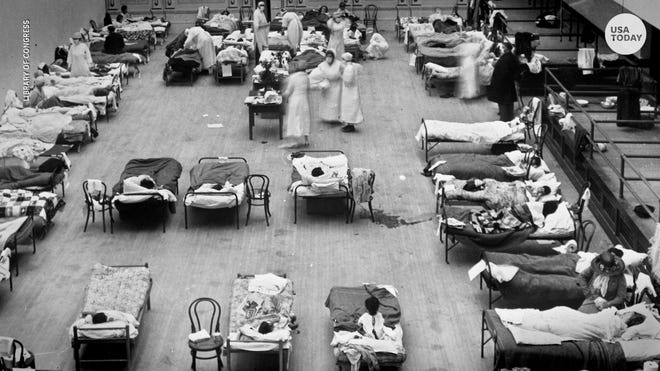
The COVID-19 pandemic continues on as we head into the colder months, but there's also another seasonal illness to remember: the flu.
Flu vaccines and nasal sprays have been available for protection against strains of the virus since the summer, and the Centers for Disease Control and Prevention recommends that people should be vaccinated by the end of October for the best protection this season.
Last year, activity for the 2020-21 flu season was unusually low, with the CDC postulating vaccines and COVID-19 mitigation measures, including wearing face masks, staying home, hand washing, school closures, increased ventilation of indoor spaces, reduced travel and physical distancing may have contributed to the decline in illness, hospitalization and deaths from the flu virus.
Additionally, a record number of flu vaccine doses were given in the U.S. during 2020 and 2021 – 193.8 million doses.
Here's what you need to know about the flu, and flu vaccines, this season.
Know the difference: COVID-19 delta variant symptoms vs. cold or allergies
When is the best time to get a flu shot?
The CDC recommends that everyone 6 months and older get a flu shot.
The best time to get a flu vaccine this year is before the end of October, according to recommendations from the CDC.
For adults, especially those older than 65, vaccination should occur later, rather than earlier in July or August because protection can decrease over time.
Children should get vaccinated as soon as it's available.
People in their third trimester of pregnancy can also get vaccinated early. The CDC says it can help protect infants during their first few months of life, before they are old enough to be vaccinated themselves.
It takes two weeks after vaccination for antibodies to develop and provide protection against the flu.
Do you need more than one dose of the flu vaccine?
The CDC recommends two doses for some children ages 6 months to 8 years old.
For those children who are either getting vaccinated for the first time or who have previously received one dose, it's recommended to get the first dose as soon as the vaccine is available (typically July or August), because the second dose needs to be given at least four weeks later.
Studies in adults have not shown any benefit from getting more than one dose during the flu season, even among the elderly and people who may be immunocompromised.
Can the flu vaccine give you the flu?
No. The vaccine given with a needle is made with either inactivated (killed) viruses, or with only a single protein from the flu virus.
The flu mist, or the nasal spray, contains live viruses that are weakened and will not cause illness.However, it's not available for all ages. The U.S. Food and Drug Administration has approved use of the nasal spray for people ages 2-49.
Shot vs. mist: What's more effective?
The CDC has no preference over which kind of vaccine is better or more effective, instead saying it's best for everyone who is able to receive protection against the flu every year.
All flu vaccines are quadrivalent, or made up of four components, meaning they are designed to protect you against four flu viruses.
What are the side effects of the flu shot?
Common side effects can include:
- Soreness.
- Redness and or swelling from the shot.
- Headache.
- Fever.
- Nausea.
- Muscle aches.
Can you get a flu shot and COVID-19 vaccine at the same time?
Jennifer Rudell, Cincinnati district leader for CVS Health and a pharmacist, told The Enquirer that people can get a flu shot and COVID-19 vaccine at the same time.
CVS pharmacies delivered more than twice the usual number of flu shots in 2020-21, and Walgreens started delivering inoculations for this season in mid-August.
More:We had an easy flu season last year. Do we now face an 'immunity debt'?
Possible COVID-19 vaccine side effects and difference from COVID-19 symptoms: What to know
How bad will the flu be this year?
While the 2020-21 flu season was relatively mild compared to previous years, not much is currently known about the effects that the 2021-22 flu season will have.
Two studies from scientists at the University of Pittsburgh Graduate School of Public Health published in August suggested the flu season is likely to be more severe than average and potentially impact younger children, due to "waning population-level immunity from the near-lack of a flu season during last winter’s COVID-19 surge," according to a news release from the University of Pittsburgh.
Both studies have suggested that flu-related hospitalizations and deaths could be reduced if vaccination rates increase between 20% and 50% from previous flu seasons.
There is a concern of a "twindemic" from COVID-19 and the flu this year, according to Cincinnati-area health care officials.
More:Less masking may mean 'twindemic' with flu in Cincinnati region
UC Health has already seen some influenza cases this season, Dr. Richard Lofgren, the health system's president and chief executive officer, said during Hamilton County's periodic pandemic briefing.
Last year, the first winter with the novel coronavirus sweeping the nation, masking and social distancing crushed the flu virus, with barely more than 100 hospitalizations statewide. The year before, more than 11,000 people needed hospital care for flu.
Hamilton County Health Commissioner Greg Kesterman said he expects more flu this year because fewer people are wearing masks in public.
Where to get a flu shot
Flu vaccines and nasal spray are available from your health care provider, local health departments, pharmacies, clinics and some schools and universities.
Some locations will offer the flu shot for free, depending on your health insurance or Medicare assistance.
Source link








